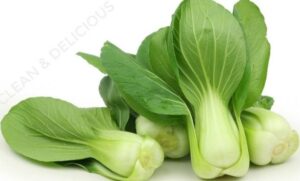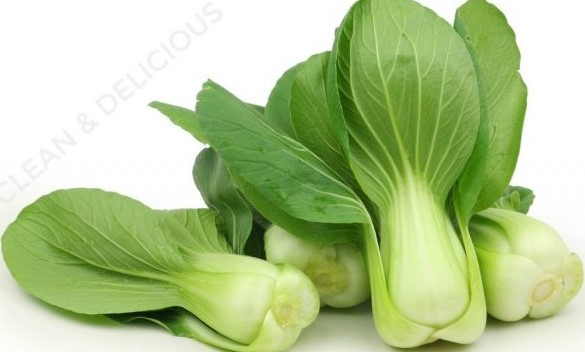Bok choy

Overview:
“Bok choy” is called in American, Canadian and Australian English. “Pak choi” is called in British English language.
It is a cruciferous vegetable, which means it’s a member of the Brassica genus, along with vegetables like broccoli, cauliflower, Brussels sprouts, and cabbage.
Specifically, it is known as Brassica rapa, sub. chinensis, a subspecies of Brassica rapa. It is closely related to cabbage and turnip.
It has a wonderfully crisp texture one would expect from a member of the cabbage family with a fresh, grassy flavor that develops as you cook it.
The vegetable is widely enjoyed in Chinese and other Asian cuisines. It is usually prepared by stir-frying, frying, or braising, but it can also be eaten raw. It is also sometimes known as Chinese white cabbage.
The vegetable is made up of long leafy stems that radiate from a bulbous central stem, similar to a bunch or celery head and about the same length.
The leaves are dark green, sometimes ruffled and sometimes flat, and the stems are white or light green, depending on the variety.
Sometimes The vegetable is harvested when immature and sold as baby bok choy.
Baby Bok vegetable can range from 3 to 6 inches in length. It tends to be slightly sweet and can be sliced like large The vegetable, separated into leaves or cooked whole.
The vegetable is a common ingredient in Chinese and other Asian cuisines and can be braised, fried and roasted. The whole plant is edible.
Nutrition
Serving Size: 100 grams
Calories:13
Total Fat: 0.2g
Cholesterol: 0mg
Sodium: 65mg
Total Carbs: 2g
Dietary Fiber: 1g
Total Sugars: 1g
Protein: 2g
Vitamin A: 223mcg
Vitamin C: 45mg
Vitamin D: 0mcg (0iu)
Vitamin E: 0.1mg
Vitamin K: 46mcg
Thiamin: 0.04mg
Riboflavin: 0.07mg
Niacin: 0.5mg
Vitamin B-6: 0.2mg
Folate: 66mcg
Vitamin B-12: 0mcg
Pantothenic Acid: 0.1mg
Choline: 6mg
Calcium: 105mg
Iron: 0.8mg
Potassium: 252mg
Phosphorus: 37mg
Magnesium: 19mg
Zinc: 0.2mg
Selenium: 1mcg
Copper: 0.01mg
Manganese: 0.16mg
Alcohol: 0g
Caffeine: 0mg
Bok Choy Recipes
Garlic Bok Choy Recipe
Ingredients
The oil
Garlic
Shallots
baby bok choy
soy sauce
sesame oil
Crushed Red Chilli (optional)
Other fantastic additions include crushed ginger, a splash of fish sauce, or a sweet chili dipping sauce.
How to cook bok choy
We want to keep our baby bok vegetable somewhat intact, so the first thing to do is cut each stalk in half or quarters (depending on the size of the The vegetable) and rinse under cold running water.
Heat a large skillet or wok over medium-high heat and add the oil.
Swirl to coat the entire surface of the pan.
As the oil heats, add the garlic and shallots and fry for 1-2 minutes, stirring constantly.
Add the bok vegetable, soy sauce and sesame oil. Toss and cover.
Cook for about 2 minutes before uncovering, tossing and covering.
Continue to cook The vegetable until the whites reach the desired doneness (I’ve found that this varies from person to person as some people prefer crunchier The vegetable, while others prefer a more well-done stir-fry).
Sprinkle with crushed red pepper, if using, and drizzle with additional sesame oil, if desired.
What to serve it
Add some shrimp for a low-carb, high-protein meal.
Serve with your favorite chicken or steak and a side of rice.
Add onions, carrots, bell peppers and broccoli for a veggie-packed stir-fry the whole family will love.
Toss with ramen and drizzle with chili sauce for a meal guaranteed to taste better than take-out.
BOK CHOY SOUP
INGREDIENTS
Baby bok choy
Sesame oil toasting
Fresh garlic and ginger
Fresh shiitake
Vegetable stock or chicken bone broth
Coconut Aminos
spring onions
Coarse sea salt
Shiitake-made mushroom seasoning This is optional but really good for vegetarian or vegan pantries.
How to cook The Soup
Clean the bok choy: Halve or quarter The vegetable and rinse in cold water.
Fry: Fry garlic and ginger with toasted sesame oil and shiitake to create a flavorful base.
Simmer: Bring the broth to a gentle boil then lower the heat to release more flavor.
Taste and Adjust: Each brand of broth tastes different. Adjust the taste and spices.
Add the bok choy: Place The vegetable stem side down as if they were standing in an up position. Then submerge the whole bundles in the broth to cook the leaf segments for 1 minute.
Garnish and serve: sprinkle with spring onions and toasted sesame oil. Serve warm or hot.
What’s Between Bok Choy and Baby Bok Choy?
Bok choy, also known as pak choy or poke choi, is a type of Chinese cabbage with smooth, broad, flat leaf blades on one end and the other end forming a bunch like celery. Can be eaten cooked or raw.
They are essentially the same.
The difference is that baby bok choy is harvested earlier to produce smaller, more tender leaves.
This means that it is much sweeter than baby bok choy and is often served directly in soups or salads.
On the other hand, bok choy is much heartier, perfect for long cooking like stir-frying.
References:
https://www.thespruceeats.com/all-about-bok-choy-2215895
